Pharisees in the Bible Meaning: Hypocrisy and Law
The Pharisees were a significant Jewish group during the Second Temple period, emerging around the second century BCE. They emphasized strict adherence to the Torah, augmented by thorough oral traditions.
Central to their beliefs were the resurrection of the dead, immortality of the soul, and divine judgment. The Pharisees’ rigorous observance of ritual purity and ethical conduct distinguished them, and their influence extended into communal governance and legal interpretations.
Despite often being portrayed negatively in the New Covenant for their legalism, their legacy profoundly shaped Rabbinic Judaism. Discover how this intricate history informs contemporary understandings of Jewish religious practice.

Key Takeaways
- The Pharisees were a Jewish sect emphasizing strict adherence to the Torah and oral traditions.
- They believed in the resurrection of the dead and divine judgment, unlike the Sadducees.
- Pharisees often clashed with Jesus over interpretations of Jewish law and religious practices.
- They played a significant role in shaping Rabbinic Judaism and its legal and ethical teachings.
Origins of the Pharisees
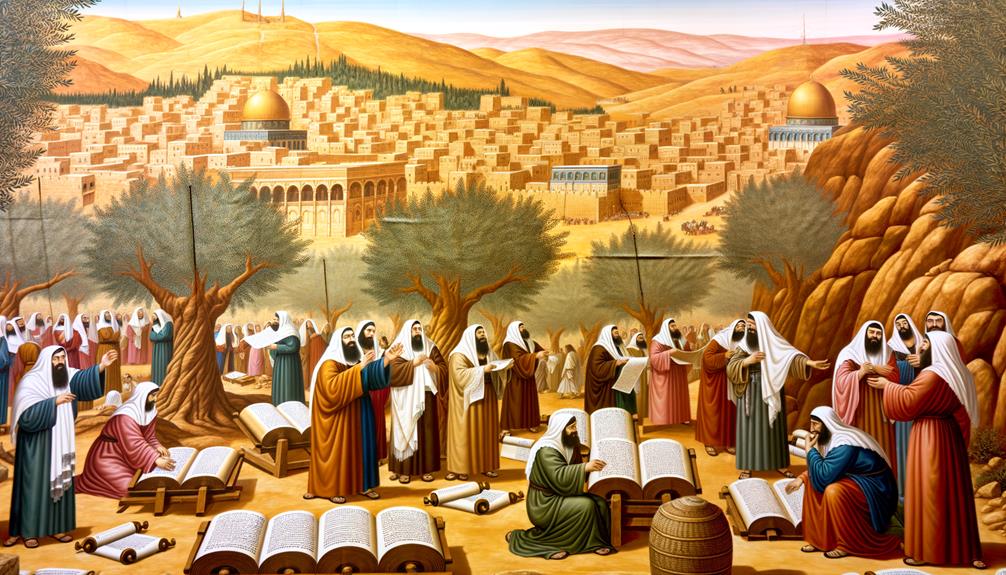
Emerging during the Second Temple period, the Pharisees were a Jewish sect whose origins can be traced back to the social and religious upheavals following the Maccabean Revolt.
This period marked significant transformations within Jewish society, wherein the Pharisees distinguished themselves by emphasizing adherence to the Torah and the oral traditions.
Their focus on ritual purity, ethical conduct, and the interpretation of Jewish law set them apart from other contemporary groups.
The Pharisees advocated for a form of Judaism that was accessible to the common people, not just the priestly elite.
Their influence extended beyond religious practices to socio-political domains, thereby shaping the spiritual and communal life of Jewish society during the Second Temple period and beyond.
Historical Background
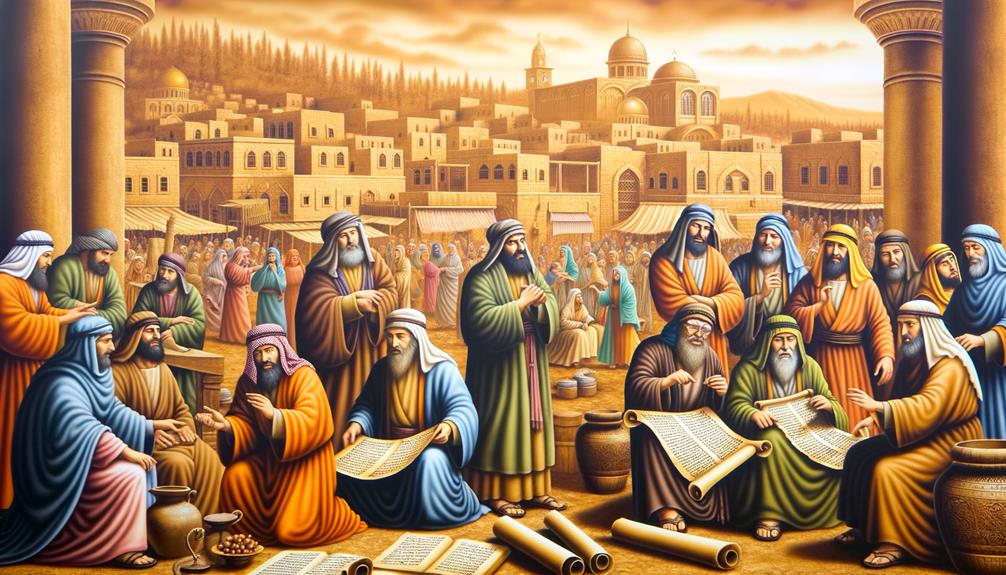
The historical background of the Pharisees is rooted in their origins during the Second Temple period, where they emerged as a distinct group within Jewish society.
Their sociopolitical influence grew markedly, particularly during the Hasmonean dynasty, shaping both religious practices and communal governance.
The Pharisees’ beliefs, including their emphasis on the oral law and adherence to purity codes, played an essential role in their identity and interactions with other Jewish sects.
Origins and Early Development
Tracing their origins to the intertestamental period, the Pharisees emerged as a significant Jewish sect during the Second Temple era, deeply influencing the religious and social fabric of ancient Israel. Their development can be traced back to the Maccabean Revolt (167-160 BCE) and the Hasmonean dynasty, where they began to distinguish themselves from other groups such as the Sadducees.
The Pharisees emphasized strict adherence to the Torah, along with oral traditions that they believed were equally binding.
- Maccabean Revolt: Catalyst for their emergence.
- Hasmonean Dynasty: Period of growth and influence.
- Torah and Oral Law: Central to their beliefs.
Their early development set the foundation for their lasting impact on Jewish religious practice.
Sociopolitical Influence
Building on their foundational emphasis on the Torah and oral traditions, the Pharisees leveraged their religious influence to become formidable players in the sociopolitical landscape of ancient Israel. Their deep-rooted connection with the common people enabled them to wield significant power, bridging the gap between the populace and the ruling elite. This influence extended beyond religious guidance, impacting legislative and judicial decisions.
| Aspect | Influence |
|---|---|
| Religious Authority | Interpreted and taught Torah, influencing daily life and moral conduct |
| Legal Influence | Participated in the Sanhedrin, shaping legal standards |
| Social Impact | Advocated for the welfare of the common people, fostering community support |
| Political Engagement | Navigated relationships with Roman authorities and Herodian rulers |
| Conflict and Division | Often clashed with Sadducees and other groups, highlighting ideological and class-based tensions |
Their involvement in these areas showcases their pivotal role in shaping the sociopolitical fabric of their time.
Religious Practices and Beliefs
Rooted in a profound reverence for the Torah and a robust tradition of oral law, the Pharisees’ religious practices and beliefs were integral to their identity and influence in ancient Jewish society. They emphasized the interpretation and application of the Torah to everyday life, fostering a dynamic and adaptive Judaism. Central to their practices were rituals and ethical codes aimed at maintaining purity and holiness.
The Pharisees believed the Torah was complemented by an oral tradition, essential for interpreting written laws.
Strict observance of purity laws, including dietary restrictions and ritual washings, was paramount.
Regular participation in communal worship and study sessions was also a critical aspect of their practice.
Unlike the Sadducees, Pharisees held a belief in the resurrection of the dead.
Core Beliefs
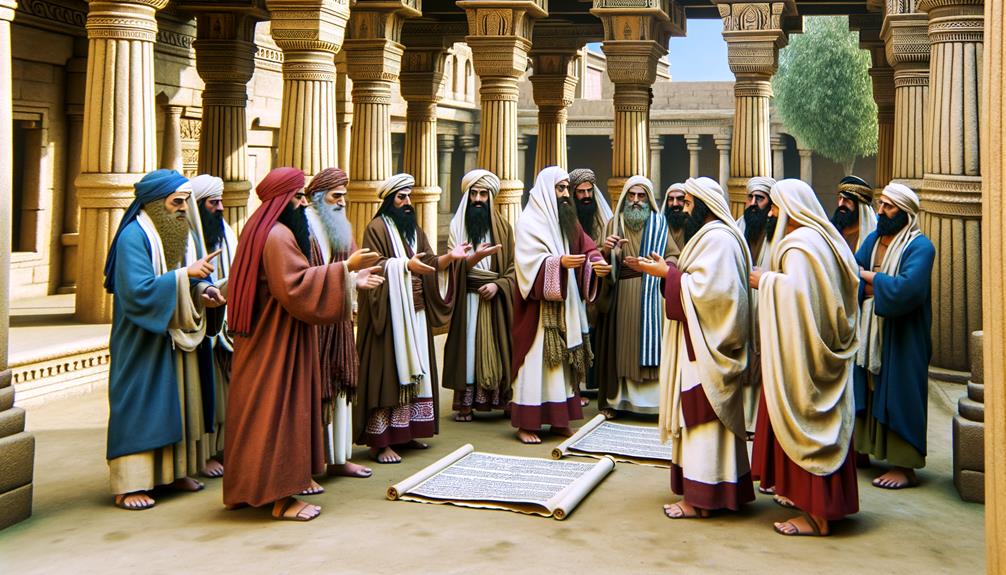
The core beliefs of the Pharisees centered around a strict adherence to the Torah, an emphasis on oral traditions, and a belief in the resurrection of the dead.
Their commitment to the Torah was unwavering, viewing it as the ultimate guide to ethical and religious conduct.
They believed that oral traditions, passed down through generations, were essential in interpreting and applying the Torah’s teachings. This oral law supplemented the written scriptures, providing detailed regulations for daily life.
In addition, the Pharisees held a distinctive belief in the resurrection, positing that the dead would rise again, an idea that contrasted with the Sadducees’ doctrine.
These core beliefs positioned the Pharisees as influential interpreters of Jewish law and theology in the Second Temple period.
Religious Practices

In alignment with their doctrinal principles, the Pharisees’ religious practices were characterized by meticulous observance of ritual purity, Sabbath laws, and dietary regulations. They adhered strictly to both the written Torah and the oral traditions that they believed were essential for proper religious life.
Key practices included:
- Ritual Purity: Pharisees maintained complex laws about cleanliness, affecting daily activities and religious functions.
- Sabbath Observance: They followed stringent rules to guarantee the Sabbath was kept holy, prohibiting specific types of work.
- Dietary Laws: Adherence to kosher dietary laws was non-negotiable, reflecting their commitment to ritual purity.
These practices underscored their devotion to upholding Jewish law thoroughly.
Influence on Judaism
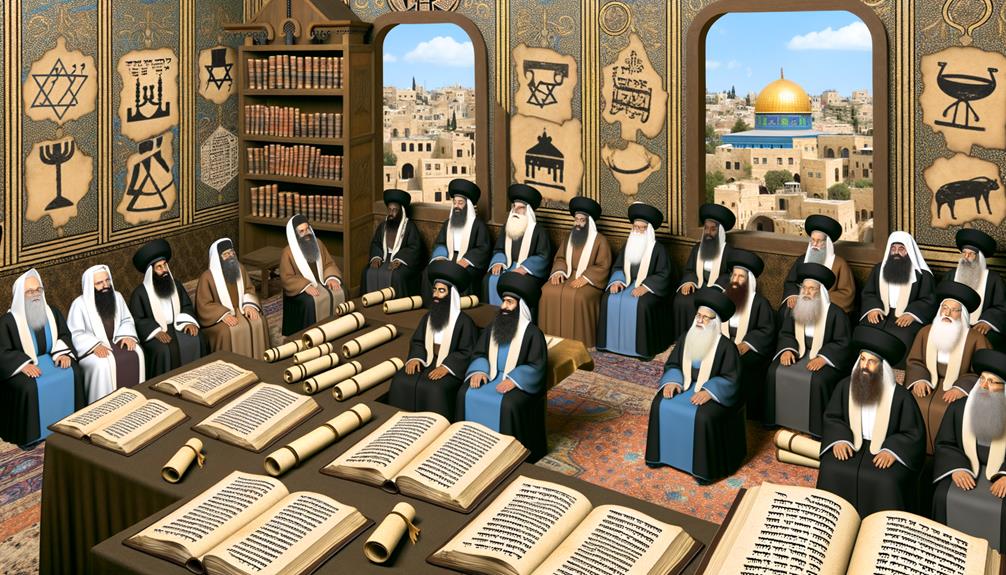
Pharisees profoundly shaped Rabbinic Judaism through their emphasis on oral traditions and interpretative teachings, which later became foundational elements of Jewish religious life and law.
Their belief in the Oral Torah, alongside the Written Torah, played a pivotal role in preserving and adapting Jewish practices during and after the Second Temple period.
The Pharisees’ focus on halakhic interpretations, ethical conduct, and communal obligations forged a dynamic framework for Jewish jurisprudence.
Additionally, their methods of textual exegesis and debate greatly influenced the development of the Talmud.
Pharisees and Jesus
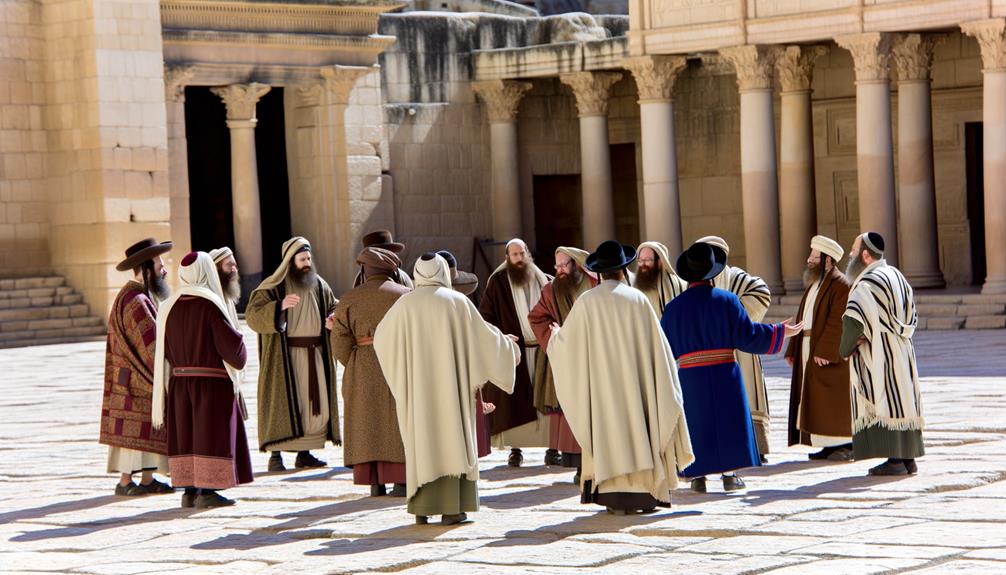
The interactions between Jesus and the Pharisees are pivotal in understanding the tension between their respective approaches to Jewish law and practice.
Jesus frequently rebuked the Pharisees for their legalistic tendencies, accusing them of prioritizing ritualistic adherence over the underlying ethical and spiritual principles.
This critique highlights a significant theological divergence, with Jesus advocating for a more compassionate and less rigid interpretation of the law.
Jesus Rebukes Pharisees
Jesus frequently rebuked the Pharisees for their hypocrisy, emphasizing their outward displays of piety while neglecting the weightier matters of justice, mercy, and faithfulness. His criticisms were not merely about their actions but also their attitudes, which highlighted a deeper moral and spiritual disconnect.
- Hypocrisy: Jesus denounced their tendency to honor God with their lips while their hearts were far from Him (Matthew 15:8).
- Legalism: He criticized them for valuing human traditions over divine commandments (Mark 7:8).
- Ostentation: The Pharisees were known for their public displays of religiosity to gain social admiration (Matthew 23:5).
These rebukes reveal Jesus’ call for authentic, inward spirituality.
Pharisees’ Legalistic Practices
Central to the conflict between Jesus and the religious authorities were the Pharisees’ stringent and often burdensome legalistic practices, which they imposed on the Jewish populace. Their meticulous adherence to the Mosaic Law extended to oral traditions, creating an intricate system of rules governing daily life.
Jesus criticized these practices for prioritizing ritual purity over genuine moral and spiritual integrity. He accused the Pharisees of hypocrisy, emphasizing that their outward displays of piety masked internal corruption.
This critique is encapsulated in passages such as Matthew 23:23-28, where Jesus condemns their emphasis on minor regulations while neglecting justice, mercy, and faithfulness.
This fundamental clash highlighted the divergence between ritualistic legalism and the core ethical teachings Jesus espoused.
Conflicts in the New Testament

Among the various conflicts in the New Scriptures, the Pharisees frequently found themselves at odds with Jesus over interpretations of Jewish law and religious practices. These clashes often centered around:
- Sabbath Observance: Jesus’ healing on the Sabbath contradicted Pharisaic prohibitions, leading to accusations of lawbreaking.
- Ritual Purity: Disagreements arose over handwashing traditions before meals, which Jesus deemed secondary to inner purity.
- Authority and Hypocrisy: Jesus criticized the Pharisees for their ostentatious displays of piety, questioning their spiritual authenticity.
These conflicts highlight the fundamental rift between Jesus’ teachings and Pharisaic interpretations, underscoring a broader theological debate within first-century Judaism.
Misconceptions and Stereotypes
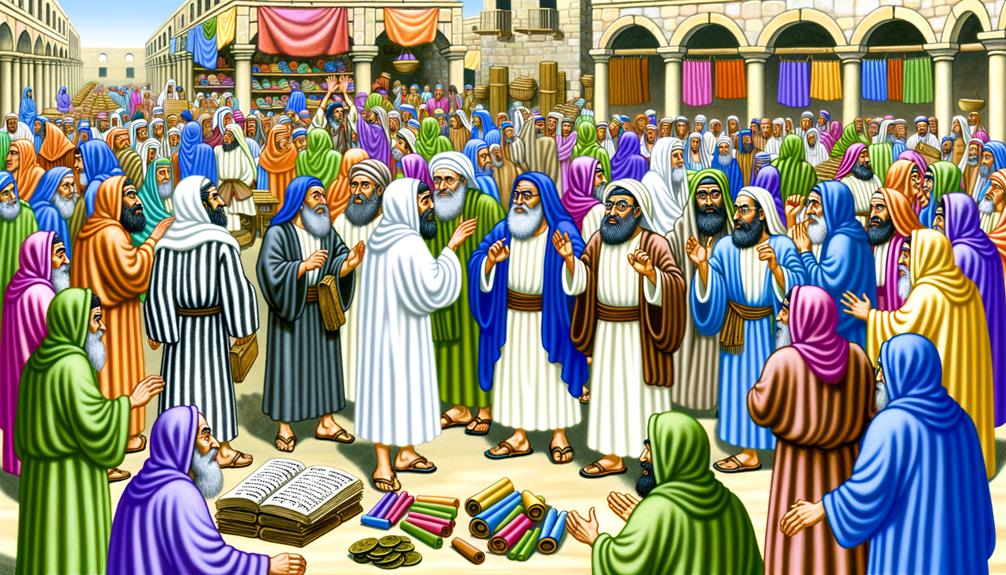
Frequently misunderstood, the Pharisees in the Bible are often portrayed through oversimplified stereotypes that fail to capture the complexity of their beliefs and societal roles.
Commonly depicted as legalistic and hypocritical adversaries of Jesus, this image overlooks their significant contributions to Jewish religious life and thought.
The Pharisees emphasized the importance of oral traditions and sought to make the Torah accessible to all Jews, contrasting with the elitism of the Sadducees.
They played a pivotal role in shaping Rabbinic Judaism, advocating for ethical conduct and spiritual integrity.
These nuanced perspectives highlight that the Pharisees were not monolithic but rather a diverse group with varying interpretations and practices, meriting a more balanced and informed understanding.
Pharisees in Jewish Tradition

Examining the Pharisees within Jewish tradition necessitates an understanding of their historical background and origin, which traces back to the Second Temple period.
Their key beliefs and practices, including a strict interpretation of the Torah and emphasis on oral traditions, greatly influenced Jewish religious life.
This analysis will illuminate how the Pharisees’ doctrines and societal roles contributed to shaping the development of Rabbinic Judaism.
Historical Background and Origin
Emerging around the second century BCE, the Pharisees became a significant sect within Judaism, distinguished by their emphasis on the interpretation and application of the Torah. Their influence grew during the Hasmonean period, reflecting a shift toward a more democratized form of religious leadership.
This period saw the Pharisees advocating for a tradition that balanced written law with oral traditions, a stance that often put them at odds with other Jewish groups such as the Sadducees.
Key elements of their historical background include:
- Origins in the Hasmonean period, around 167-164 BCE.
- Emphasis on oral tradition alongside written scripture.
- Advocacy for laws applicable to everyday life, influencing laypeople.
These factors underscore their lasting impact on Jewish tradition.
Key Beliefs and Practices
Building on their historical background, the Pharisees’ key beliefs and practices were characterized by their rigorous adherence to both the written Torah and the extensive body of oral law, which they believed provided necessary interpretation and guidance for daily life.
Central to their theological framework was the belief in the immortality of the soul, resurrection of the dead, and divine judgment. They emphasized purity laws, tithing, and ritual observances, aiming to extend temple holiness to everyday life.
The Pharisees’ focus on the oral law, later codified in the Mishnah, underscored their commitment to adaptability and relevance in changing social contexts. Their interpretive traditions greatly influenced Rabbinic Judaism, shaping Jewish practice and thought long after the Second Temple’s destruction.
Legacy and Impact

The legacy and impact of the Pharisees in the Bible extend beyond their historical role, influencing various aspects of Jewish religious tradition and Christian theological interpretation. Their contributions to religious thought and practice have left a lasting imprint, including the following significant elements:
- Development of Rabbinic Judaism: The Pharisaic emphasis on oral tradition laid the groundwork for Rabbinic Judaism.
- Scriptural Exegesis: Pharisaic methods of scriptural interpretation continue to shape Jewish and Christian hermeneutics.
- Ethical and Liturgical Practices: Many ethical teachings and liturgical practices in contemporary Judaism are rooted in Pharisaic traditions.
Understanding these facets provides a nuanced view of their enduring influence.
Modern Interpretations
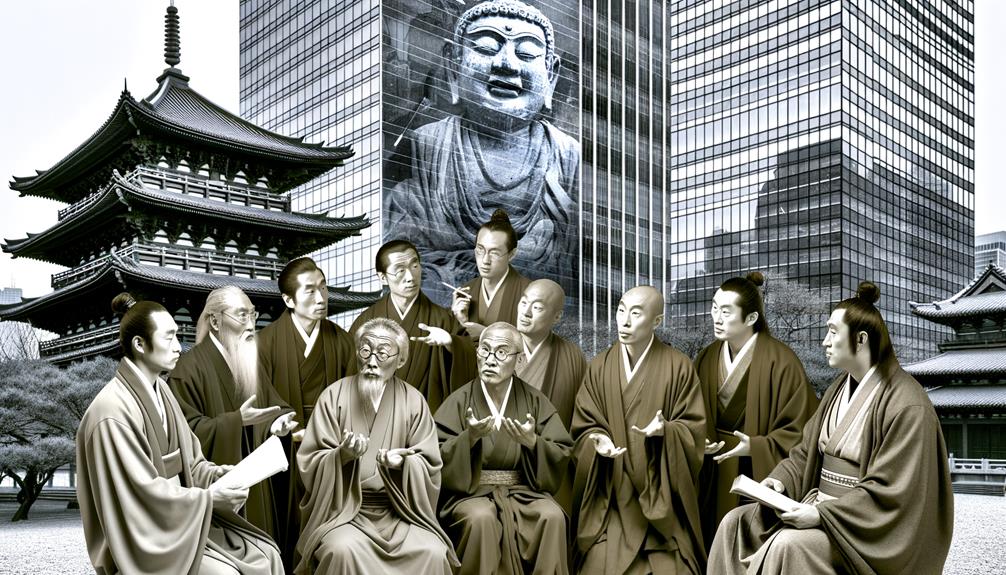
In contemporary scholarship, the Pharisees are re-evaluated through the lens of modern historiography, leading to diverse interpretations that challenge traditional views.
Scholars now emphasize the Pharisees’ role in preserving Jewish identity and law during a time of Roman occupation.
The negative portrayals found in the New writings are reconsidered as reflections of early Christian-Jewish conflicts rather than objective historical accounts.
Recent studies highlight their dedication to ethical monotheism and community welfare, presenting them as progressive reformers rather than hypocritical legalists.
This nuanced understanding fosters a more balanced view, recognizing their contributions to Judaism and their complex relationship with early Christianity.
Consequently, modern interpretations encourage a reassessment of the Pharisees’ historical and religious significance.
Conclusion
Despite historical misconceptions and stereotypes, their influence remains profound and enduring. The legacy of the Pharisees, much like an ancient tapestry, is interwoven with the fabric of Jewish tradition and continues to be reevaluated in contemporary scholarship.
The Pharisees, akin to a deep-rooted tree, have left an indelible mark on the landscape of Judaism. Their core beliefs, religious practices, and interpretative traditions have cultivated a rich soil from which modern Jewish thought continues to grow.






